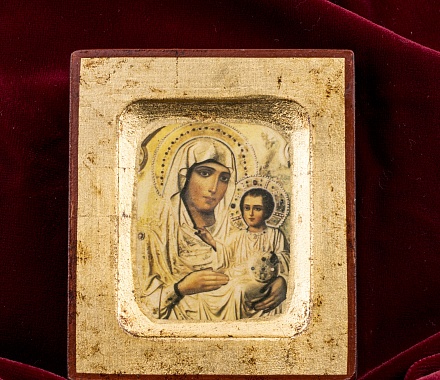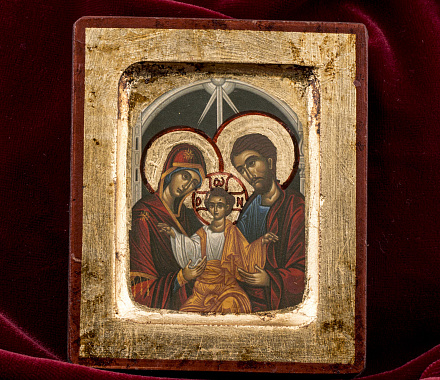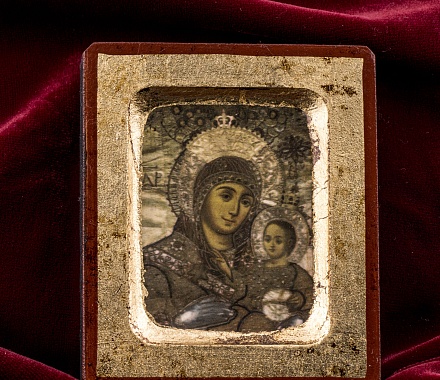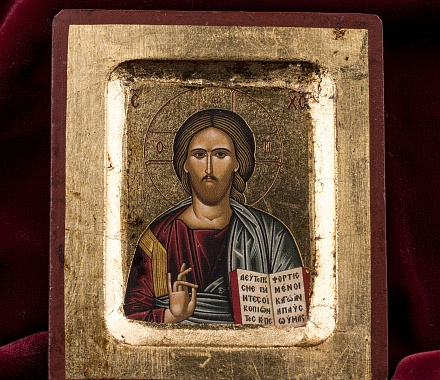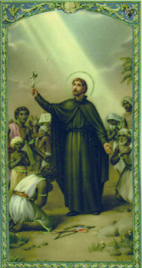
Feastday: December 3
Patron: of Catholic missions; African missions; Goa, India; China; missionaries
Birth: 1506
Death: 1552
Beatified: Oct. 25, 1619 by Pope Paul V
Canonized: March 12, 1622 by Pope Gregory XV
St. Francis Xavier was a Navarrese-Basque Roman Catholic missionary born in the Kingdom of Navarre on April 7, 1506. His father was a privy counselor and finance minister to King John III of Navarre. He was the youngest in his family and resided in a castle which still partially stands today and is in the possession of the Jesuit order.
As the young Francis grew, he was surrounded by war. Navarre was the target of a campaign by King Ferdinand of Aragon and Castile, and the kingdom was eventually conquered.
When the war stopped and Francis came of age, he was sent to study at the University of Paris. While there he roomed with his friend, Peter Favre. The pair met and were heavily influenced by Ignatius of Loyola, who encouraged Francis to become a priest.
In 1530, Francis Xavier earned his master's degree, and went on to teach philosophy at the University of Paris.
On August 15, 1534, Francis Xavier along with Peter Favre, and several other friends, made vows of poverty, chastity, and obedience. The men planned to travel to the Holy Land to convert non-believers. Francis Xavier started his study of theology that same year and was ordained on June 24, 1537.
Pope Paul III approved the formation of their order in 1540, which became The Society of Jesus. The order is more popularly became known as the Jesuits.
While Francis Xavier was becoming a priest, Portugal was colonizing India. The Portuguese settlers in India and elsewhere were losing their faith and Christian values. To restore these values, the King of Portugal asked the Pope to send missionaries to the region.
Pope Paul III asked the new order to take the mission, particularly since they could not undertake their preferred mission to the Holy Land due to warfare there. Ignatius ultimately decided to send Francis.
Francis Xavier left for India in 1541, on his thirty-fifth birthday. As he departed he was informed that the pope appointed him to be the Papal Nuncio in the East. A Papal Nuncio is a diplomat who takes up permanent residence in another country to formally represent the Church there. He arrived in the region and colony of Goa, India on May 6, 1542.
Although Goa had churches and even a bishop in the Portuguese colony, there were few people to preach and minister to the Portuguese, especially outside the walls of the city.
A major problem Francis quickly recognized was the nature of the people and their intentions. Many sailors and settlers were former prisoners who had been recruited from Portuguese jails or were fleeing mistakes they made back home. None of them came to spread or live virtuous lives. Instead they came to escape Portugal, find adventure, or to make fortunes. Still, they settled and made families.
Xavier ministered first to the sick and the children. Then he learned about the native people of the Pearl Fishery Coast, which had been baptized a decade earlier, but were never taught their faith. Xavier began ministering to them. He spent three years among them, but was often embarrassed by the conduct of his Portuguese countrymen who were already Catholic, but frequently misbehaved.
Xavier built 40 churches for the people of the Pearl Fishery Coast. Xavier encountered difficulty in his mission because he usually worked to convert the people first, instead of their leaders.
Xavier eventually decided to travel to Malacca and the Maluku Islands to evangelize the people there. He spent about two years in the region, and while in Malacca, a Japanese man named Anjiro caught up with him. Anjiro was accused of murder in Japan but had managed to flee. Learning about Xavier, he decided to find Xavier and tell him about Japan, which he did. Xavier converted Anjiro to Christianity, making him the first Japanese convert to Christianity.
Xavier returned to Goa for about a year to attend to his official responsibilities, but he was very interested in visiting Japan. In 1549, he finally departed for the country, arriving in July of that year.
The local daimyo warmly received Xavier, but forbade his subjects from converting to Christianity. In addition to the legal obstacle, Xavier found language to be a barrier. The Japanese language was different than any other he had previously encountered.
Xavier was surprised to find that his poverty was a barrier to his communication. Poverty was not respected in feudal Japan as it was in Europe, so Xavier was compelled to change his strategy. On one occasion, when meeting with a local prince, Xavier arranged to be finely dressed and for his fellow missionaries to wait on him. He had gifts from India delivered to him. The charade had the desired effect and improved his reputation.
Despite his efforts, the Japanese were not easily converted. Most held fast to their traditional Buddhist or Shinto beliefs. The Japanese also found the concept of hell as a place of eternal torment to be difficult to accept.
Some traditionalists, including priests from the native religions, grew hostile toward Xavier and Christianity. Xavier established a few congregations, but the religion was suppressed from spreading by the nobility to grew to mistrust the outsiders and their faith. Eventually, Christianity became the subject of great persecution, forcing many to go underground with their belief.
Xavier finished his work in Japan for the time and decided to return to India with a stop in Goa. During his voyage, he was petitioned to meet with the Chinese emperor and argue for the release of several Portuguese prisoners as a representative of their government. Xavier decided to make the trip to China, but first felt the need to return to his headquarters in Goa.
He departed India for the last time in April, 1552 and stopped in Malacca to obtain official documents attesting to his status as a representative of the Portuguese king. However, the harbor in Malacca was now controlled by Alvaro da Gama, the Captain of Malaca and the son of Vasco da Gama.
Da Gama was not friendly to Xavier who refused to recognize his official status as Papal Nuncio. He confiscated the gifts Xavier intended for the Chinese emperor and staffed his ship with a new crew, loyal to himself.
Xavier's ship reached China in August, stopping at an island off the Chinese coast. From there, Xavier was on his own. He managed to find a man to agree to take him to China for a large fee, but while he was waiting for his boat to arrive became ill with a fever. Xavier died on December 3, 1552.
Xavier was buried on the island until February 1553 when his body was removed and taken to Malacca where it was buried at a church for a month. Then one of Xavier?s companions moved his body to his own residence for the rest of the year. In December, his body was moved to Goa. Xavier remains buried in a silver casket enclosed in a glass case.
Several of his bones have been removed. His right arm, used to bless converts, is on display in Rome. Another arm bone is kept on Coloane island, in Macau, which today is part of China.
Xavier was beatified by Pope Paul V on Oct. 25, 1619, and canonized by Gregory XV on March 12, 1622 at the same ceremony as Ignatius of Loyola. He is the patron of Catholic missions and his feast day is on December 3.
16th-century Roman Catholic saint and missionary This article is about the person. For schools and other uses, see St. Xavier (disambiguation). "François Xavier" redirects here. For the French journalist, see François Xavier (journalist).
| Part of a series on the |
| Society of Jesus |
|---|
 Christogram of the Jesuits Christogram of the Jesuits |
| History |
|
| Hierarchy |
|
| Spirituality |
|
| Works |
|
| Notable Jesuits |
|
|
|
|
Francis Xavier (born Francisco de Jasso y Azpilicueta; Latin: Franciscus Xaverius; Basque: Frantzisko Xabierkoa; French: François Xavier, Spanish: Francisco Javier; Portuguese: Francisco Xavier; (7 April 1506 – 3 December 1552), venerated as Saint Francis Xavier, was a Navarrese Catholic missionary and saint who was a co-founder of the Society of Jesus.
Born in Javier (Xavier in Old Spanish and in Navarro-Aragonese, or Xabier (Basque language for "new house")), Kingdom of Navarre (in present-day Spain), he was a companion of Ignatius of Loyola and one of the first seven Jesuits who took vows of poverty and chastity at Montmartre, Paris in 1534. He led an extensive mission into Asia, mainly in the Portuguese Empire of the time and was influential in evangelization work, most notably in India. Although some sources claim that the Goa Inquisition was proposed by Francis Xavier, his letter to the king of Portugal, John III, asked for a special minister whose sole office would be to further Christianity in Goa. He also was the first Christian missionary to venture into Japan, Borneo, the Maluku Islands, and other areas. In those areas, struggling to learn the local languages and in the face of opposition, he had less success than he had enjoyed in India. Xavier was about to extend his missionary preaching to China when he died on Shangchuan Island.
He was beatified by Pope Paul V on 25 October 1619 and canonized by Pope Gregory XV on 12 March 1622. In 1624, he was made co-patron of Navarre. Known as the "Apostle of the Indies" and "Apostle of Japan", he is considered to be one of the greatest missionaries since Paul the Apostle. In 1927, Pope Pius XI published the decree "Apostolicorum in Missionibus" naming Francis Xavier, along with Thérèse of Lisieux, co-patron of all foreign missions. He is now co-patron saint of Navarre, with Fermin. The Day of Navarre in Navarre, Spain, marks the anniversary of Francis Xavier's death, on 3 December 1552.
Early life
 The castle of the Xavier family was later acquired by the Society of Jesus.
The castle of the Xavier family was later acquired by the Society of Jesus.
Francis Xavier was born in the royal castle of Xavier, in the Kingdom of Navarre, on 7 April 1506 according to a family register. He was the youngest son of Juan de Jasso y Atondo, seneschal of Xavier castle, who belonged to a prosperous farming family and had acquired a doctorate in law at the University of Bologna. Basque was his mother tongue. Juan later became a privy counsellor and finance minister to King John III of Navarre (Jean d'Albret). Francis's mother was Doña María de Azpilcueta y Aznárez, sole heiress of two noble Navarrese families. He was through her related to the great theologian and philosopher Martín de Azpilcueta.
In 1512, Ferdinand, King of Aragon and regent of Castile, invaded Navarre, initiating a war that lasted over 18 years. Three years later, Francis's father died when Francis was only nine years old. In 1516, Francis's brothers participated in a failed Navarrese-French attempt to expel the Spanish invaders from the kingdom. The Spanish Governor, Cardinal Cisneros, confiscated the family lands, demolished the outer wall, the gates, and two towers of the family castle, and filled in the moat. In addition, the height of the keep was reduced by half. Only the family residence inside the castle was left. In 1522, one of Francis's brothers participated with 200 Navarrese nobles in dogged but failed resistance against the Castilian Count of Miranda in Amaiur, Baztan, the last Navarrese territorial position south of the Pyrenees.
In 1525, Francis went to study in Paris at the Collège Sainte-Barbe, University of Paris, where he spent the next eleven years. In the early days he acquired some reputation as an athlete and a high-jumper.
In 1529, Francis shared lodgings with his friend Pierre Favre. A new student, Ignatius of Loyola, came to room with them. At 38, Ignatius was much older than Pierre and Francis, who were both 23 at the time. Ignatius convinced Pierre to become a priest, but was unable to convince Francis, who had aspirations of worldly advancement. At first Francis regarded the new lodger as a joke and was sarcastic about his efforts to convert students. When Pierre left their lodgings to visit his family and Ignatius was alone with Francis, he was able to slowly break down Francis's resistance. According to most biographies Ignatius is said to have posed the question: "What will it profit a man to gain the whole world, and lose his own soul?" However, according to James Broderick such method is not characteristic of Ignatius and there is no evidence that he employed it at all.
In 1530, Francis received the degree of Master of Arts, and afterwards taught Aristotelian philosophy at Beauvais College, University of Paris.
Missionary work
 Church of Saint-Pierre de Montmartre, Paris
Church of Saint-Pierre de Montmartre, Paris
On 15 August 1534, seven students met in a crypt beneath the Church of Saint Denis (now Saint Pierre de Montmartre), on the hill of Montmartre, overlooking Paris. They were Francis, Ignatius of Loyola, Alfonso Salmeron, Diego Laínez, Nicolás Bobadilla from Spain, Peter Faber from Savoy, and Simão Rodrigues from Portugal. They made private vows of poverty, chastity, and obedience to the Pope, and also vowed to go to the Holy Land to convert infidels. Francis began his study of theology in 1534 and was ordained on 24 June 1537.
In 1539, after long discussions, Ignatius drew up a formula for a new religious order, the Society of Jesus (the Jesuits). Ignatius's plan for the order was approved by Pope Paul III in 1540.
In 1540, King John of Portugal had Pedro Mascarenhas, Portuguese ambassador to the Holy See, request Jesuit missionaries to spread the faith in his new possessions in India, where the king believed that Christian values were eroding among the Portuguese. After successive appeals to the Pope asking for missionaries for the East Indies under the Padroado agreement, John III was encouraged by Diogo de Gouveia, rector of the Collège Sainte-Barbe, to recruit the newly graduated students who had established the Society of Jesus.
 Francisco Xavier taking leave of John III of Portugal for an expedition
Francisco Xavier taking leave of John III of Portugal for an expedition
Ignatius promptly appointed Nicholas Bobadilla and Simão Rodrigues. At the last moment, however, Bobadilla became seriously ill. With some hesitance and uneasiness, Ignatius asked Francis to go in Bobadilla's place. Thus, Francis Xavier began his life as the first Jesuit missionary almost accidentally.
Leaving Rome on 15 March 1540, in the Ambassador's train, Francis took with him a breviary, a catechism, and De Institutione bene vivendi by Croatian humanist Marko Marulić, a Latin book that had become popular in the Counter-Reformation. According to a 1549 letter of F. Balthasar Gago from Goa, it was the only book that Francis read or studied. Francis reached Lisbon in June 1540 and, four days after his arrival, he and Rodrigues were summoned to a private audience with the King and the Queen.
Francis Xavier devoted much of his life to missions in Asia, mainly in four centres: Malacca, Amboina and Ternate, Japan, and off-shore China. His growing information about new places indicated to him that he had to go to what he understood were centres of influence for the whole region. China loomed large from his days in India. Japan was particularly attractive because of its culture. For him, these areas were interconnected; they could not be evangelised separately.
Goa and India
 Saint Francis Xavier preaching in Goa (1610), by André Reinoso
Saint Francis Xavier preaching in Goa (1610), by André Reinoso
Francis Xavier left Lisbon on 7 April 1541, his thirty-fifth birthday, along with two other Jesuits and the new viceroy Martim Afonso de Sousa, on board the Santiago. As he departed, Francis was given a brief from the pope appointing him apostolic nuncio to the East. From August until March 1542 he remained in Portuguese Mozambique, and arrived in Goa, then capital of Portuguese India, on 6 May 1542, thirteen months after leaving Lisbon.
The Portuguese, following quickly on the great voyages of discovery, had established themselves at Goa thirty years earlier. Francis's primary mission, as ordered by King John III, was to restore Christianity among the Portuguese settlers. According to Teotonio R. DeSouza, recent critical accounts indicate that apart from the posted civil servants, "the great majority of those who were dispatched as 'discoverers' were the riff-raff of Portuguese society, picked up from Portuguese jails." Nor did the soldiers, sailors, or merchants come to do missionary work, and Imperial policy permitted the outflow of disaffected nobility. Many of the arrivals formed liaisons with local women and adopted Indian culture. Missionaries often wrote against the "scandalous and undisciplined" behaviour of their fellow Christians.
The Christian population had churches, clergy, and a bishop, but there were few preachers and no priests beyond the walls of Goa. The Velliapura family of Velim, Goa, of the St Thomas Christians sect, welcomed the missionaries. Xavier decided that he must begin by instructing the Portuguese themselves, and gave much of his time to the teaching of children. The first five months he spent in preaching and ministering to the sick in the hospitals. After that, he walked through the streets ringing a bell to summon the children and servants to catechism. He was invited to head Saint Paul's College, a pioneer seminary for the education of secular priests, which became the first Jesuit headquarters in Asia.
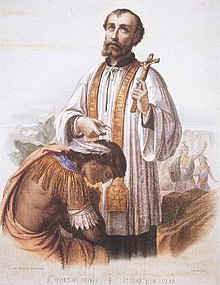 Conversion of the Paravars by Francis Xavier in South India, in a 19th-century colored lithograph
Conversion of the Paravars by Francis Xavier in South India, in a 19th-century colored lithograph
Xavier soon learned that along the Pearl Fishery Coast, which extends from Cape Comorin on the southern tip of India to the island of Mannar, off Ceylon (Sri Lanka), there was a Jāti of people called Paravas. Many of them had been baptised ten years before, merely to please the Portuguese who had helped them against the Moors, but remained uninstructed in the faith. Accompanied by several native clerics from the seminary at Goa, he set sail for Cape Comorin in October 1542. He taught those who had already been baptised, and preached to those who weren't. His efforts with the high-caste Brahmins remained unavailing.
He devoted almost three years to the work of preaching to the people of southern India and Ceylon, converting many. He built nearly 40 churches along the coast, including St. Stephen's Church, Kombuthurai, mentioned in his letters dated 1544.
During this time, he was able to visit the tomb of Thomas the Apostle in Mylapore (now part of Madras/Chennai then in Portuguese India). He set his sights eastward in 1545 and planned a missionary journey to Makassar on the island of Celebes (today's Indonesia).
As the first Jesuit in India, Francis had difficulty achieving much success in his missionary trips. His successors, such as de Nobili, Matteo Ricci, and Beschi, attempted to convert the noblemen first as a means to influence more people, while Francis had initially interacted most with the lower classes; (later though, in Japan, Francis changed tack by paying tribute to the Emperor and seeking an audience with him).
 Voyages of Saint Francis Xavier
Voyages of Saint Francis Xavier
Southeast Asia
In the spring of 1545 Xavier started for Portuguese Malacca. He laboured there for the last months of that year. About January 1546, Xavier left Malacca for the Maluku Islands, where the Portuguese had some settlements. For a year and a half he preached the Gospel there. He went first to Ambon Island, where he stayed until mid-June. He then visited other Maluku Islands, including Ternate, Baranura, and Morotai. Shortly after Easter 1547, he returned to Ambon Island; a few months later he returned to Malacca.
Japan
Main article: History of Roman Catholicism in JapanIn Malacca in December 1547, Francis Xavier met a Japanese man named Anjirō. Anjirō had heard of Francis in 1545 and had travelled from Kagoshima to Malacca to meet him. Having been charged with murder, Anjirō had fled Japan. He told Francis extensively about his former life, and the customs and culture of his homeland. Anjirō became the first Japanese Christian and adopted the name of 'Paulo de Santa Fé'. He later helped Xavier as a mediator and interpreter for the mission to Japan that now seemed much more possible.
In January 1548 Francis returned to Goa to attend to his responsibilities as superior of the mission there. The next 15 months were occupied with various journeys and administrative measures. He left Goa on 15 April 1549, stopped at Malacca, and visited Canton. He was accompanied by Anjiro, two other Japanese men, Father Cosme de Torrès and Brother Juan Fernández. He had taken with him presents for the "King of Japan" since he was intending to introduce himself as the Apostolic Nuncio.
Europeans had already come to Japan: the Portuguese had landed in 1543 on the island of Tanegashima, where they introduced matchlock firearms to Japan.
From Amboina, he wrote to his companions in Europe: "I asked a Portuguese merchant, ... who had been for many days in Anjirō's country of Japan, to give me ... some information on that land and its people from what he had seen and heard. ...All the Portuguese merchants coming from Japan tell me that if I go there I shall do great service for God our Lord, more than with the pagans of India, for they are a very reasonable people." (To His Companions Residing in Rome, From Cochin, 20 January 1548, no. 18, p. 178).
Francis Xavier reached Japan on 27 July 1549, with Anjiro and three other Jesuits, but he was not permitted to enter any port his ship arrived at until 15 August, when he went ashore at Kagoshima, the principal port of Satsuma Province on the island of Kyūshū. As a representative of the Portuguese king, he was received in a friendly manner. Shimazu Takahisa (1514–1571), daimyō of Satsuma, gave a friendly reception to Francis on 29 September 1549, but in the following year he forbade the conversion of his subjects to Christianity under penalty of death; Christians in Kagoshima could not be given any catechism in the following years. The Portuguese missionary Pedro de Alcáçova would later write in 1554:
In Cangoxima, the first place Father Master Francisco stopped at, there were a good number of Christians, although there was no one there to teach them; the shortage of labourers prevented the whole kingdom from becoming Christian.
— Pacheco 1974, pp. 477–480
He was hosted by Anjirō's family until October 1550. From October to December 1550, he resided in Yamaguchi. Shortly before Christmas, he left for Kyoto but failed to meet with the Emperor. He returned to Yamaguchi in March 1551, where the daimyo of the province gave him permission to preach. However, lacking fluency in the Japanese language, he had to limit himself to reading aloud the translation of a catechism.
Francis was the first Jesuit to go to Japan as a missionary. He brought with him paintings of the Madonna and the Madonna and Child. These paintings were used to help teach the Japanese about Christianity. There was a huge language barrier as Japanese was unlike other languages the missionaries had previously encountered. For a long time Francis struggled to learn the language.
Having learned that evangelical poverty did not have the appeal in Japan that it had in Europe and in India, he decided to change his approach. Hearing after a time that a Portuguese ship had arrived at a port in the province of Bungo in Kyushu and that the prince there would like to see him, Xavier now set out southward. The Jesuit, in a fine cassock, surplice, and stole, was attended by thirty gentlemen and as many servants, all in their best clothes. Five of them bore on cushions valuable articles, including a portrait of Our Lady and a pair of velvet slippers, these not gifts for the prince, but solemn offerings to Xavier, to impress the onlookers with his eminence. Handsomely dressed, with his companions acting as attendants, he presented himself before Oshindono, the ruler of Nagate, and as a representative of the great kingdom of Portugal, offered him letters and presents: a musical instrument, a watch, and other attractive objects which had been given him by the authorities in India for the emperor.
For forty-five years the Jesuits were the only missionaries in Asia, but the Franciscans also began proselytising in Asia as well. Christian missionaries were later forced into exile, along with their assistants. Some were able to stay behind, however Christianity was then kept underground so as to not be persecuted.
The Japanese people were not easily converted; many of the people were already Buddhist or Shinto. Francis tried to combat the disposition of some of the Japanese that a God who had created everything, including evil, could not be good. The concept of Hell was also a struggle; the Japanese were bothered by the idea of their ancestors living in Hell. Despite Francis's different religion, he felt that they were good people, much like Europeans, and could be converted.
Xavier was welcomed by the Shingon monks since he used the word Dainichi for the Christian God; attempting to adapt the concept to local traditions. As Xavier learned more about the religious nuances of the word, he changed to Deusu from the Latin and Portuguese Deus. The monks later realised that Xavier was preaching a rival religion and grew more aggressive towards his attempts at conversion.
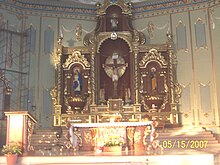 The Altar of St. Francis Xavier Parish in Nasugbu, Batangas, Philippines. Saint Francis is the principal patron of the town, together with Our Lady of Escalera.
The Altar of St. Francis Xavier Parish in Nasugbu, Batangas, Philippines. Saint Francis is the principal patron of the town, together with Our Lady of Escalera.
With the passage of time, his sojourn in Japan could be considered somewhat fruitful as attested by congregations established in Hirado, Yamaguchi, and Bungo. Xavier worked for more than two years in Japan and saw his successor-Jesuits established. He then decided to return to India. Historians debate the exact path by which he returned, but from evidence attributed to the captain of his ship, he may have travelled through Tanegeshima and Minato, and avoided Kagoshima because of the hostility of the daimyo.
China
During his trip from Japan back to India, a tempest forced him to stop on an island near Guangzhou, Guangdong, China, where he met Diogo Pereira, a rich merchant and an old friend from Cochin. Pereira showed him a letter from Portuguese prisoners in Guangzhou, asking for a Portuguese ambassador to speak to the Chinese Emperor on their behalf. Later during the voyage, he stopped at Malacca on 27 December 1551, and was back in Goa by January 1552.
On 17 April he set sail with Diogo Pereira on the Santa Cruz for China. He planned to introduce himself as Apostolic Nuncio and Pereira as ambassador of the King of Portugal. But then he realized that he had forgotten his testimonial letters as an Apostolic Nuncio. Back in Malacca, he was confronted by the captain Álvaro de Ataíde da Gama who now had total control over the harbour. The captain refused to recognize his title of Nuncio, asked Pereira to resign from his title of ambassador, named a new crew for the ship, and demanded the gifts for the Chinese Emperor be left in Malacca.
In late August 1552, the Santa Cruz reached the Chinese island of Shangchuan, 14 km away from the southern coast of mainland China, near Taishan, Guangdong, 200 km south-west of what later became Hong Kong. At this time, he was accompanied only by a Jesuit student, Álvaro Ferreira, a Chinese man called António, and a Malabar servant called Christopher. Around mid-November he sent a letter saying that a man had agreed to take him to the mainland in exchange for a large sum of money. Having sent back Álvaro Ferreira, he remained alone with António. He died from a fever at Shangchuan, Taishan, China, on 3 December 1552, while he was waiting for a boat that would take him to mainland China.
Burials and relics
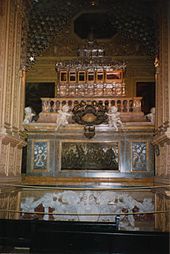 Casket of Saint Francis Xavier in the Basilica of Bom Jesus in Goa, India
Casket of Saint Francis Xavier in the Basilica of Bom Jesus in Goa, India
Xavier was first buried on a beach at Shangchuan Island, Taishan, Guangdong. His body was taken from the island in February 1553 and temporarily buried in St. Paul's church in Portuguese Malacca on 22 March 1553. An open grave in the church now marks the place of Xavier's burial. Pereira came back from Goa, removed the corpse shortly after 15 April 1553, and moved it to his house. On 11 December 1553, Xavier's body was shipped to Goa.
The body is now in the Basilica of Bom Jesus in Goa, where it was placed in a glass container encased in a silver casket on 2 December 1637. This casket, constructed by Goan silversmiths between 1636 and 1637, was an exemplary blend of Italian and Indian aesthetic sensibilities. There are 32 silver plates on all four sides of the casket, depicting different episodes from the life of Xavier:
- Francis lies on the ground with his arms and legs tied, but the cords break miraculously.
- Francis kisses the ulcer of a patient in a Venetian hospital.
- He is visited by Jerom as he lies ailing in the hospital of Vicenza.
- A vision about his future apostolate.
- A vision about his sister's prophecy about his fate.
- He saves the secretary of the Portuguese Ambassador while crossing the Alps.
- He lifts a sick man who dies after receiving communion but freed from fever.
- He baptises in Travancore.
- He resuscitates a boy who died in a well at Cape Comorin.
- He cures miraculously a man full of sores.
- He drives away the Badagas in Travancore.
- He resuscitates three persons: a man who was buried at Coulao; a boy about to be buried at Multao; and a child.
- He takes money from his empty pockets and gives to a Portuguese at Malyapore.
- A miraculous cure.
- A crab restores his crucifix which had fallen into the sea.
- He preaches in the island of Moro.
- He preaches in the sea of Malacca and announces the victory against the enemies.
- He converts a Portuguese soldier.
- He helps the dying Vicar of Malacca.
- Francis kneels down and on his shoulders there rests a child whom he restores to health.
- He goes from Amanguchi to Macao walking.
- He cures a dumb and paralytic man in Amanguchi.
- He cures a deaf Japanese person.
- He prays in the ship during a storm.
- He baptises three kings in Cochin.
- He cures a religious in the college of St. Paul.
- Due to the lack of water, he sweetens the sea water during a voyage.
- The agony of Francis at Sancian.
- After his death he is seen by a lady according to his promise.
- The body dressed in sacerdotal vestments is exposed for public veneration.
- Francis levitates as he distributes communion in the College of St. Paul.
- The body is placed in a niche at Chaul with lighted candles. On the top of this casket there is a cross with two angels. One is holding a burning heart and the other a legend which says, "Satis est Domine, satis est." (It's enough Lord, it's enough)
The right forearm, which Xavier used to bless and baptise his converts, was detached by Superior General Claudio Acquaviva in 1614. It has been displayed since in a silver reliquary at the main Jesuit church in Rome, Il Gesù.
 Saint Francis Xavier's humerus at St. Joseph's Church, Macao (2008)
Saint Francis Xavier's humerus at St. Joseph's Church, Macao (2008) Sign accompanying Saint Francis Xavier's humerus
Sign accompanying Saint Francis Xavier's humerus
Another of Xavier's arm bones was brought to Macau where it was kept in a silver reliquary. The relic was destined for Japan but religious persecution there persuaded the church to keep it in Macau's Cathedral of St. Paul. It was subsequently moved to St. Joseph's and in 1978 to the Chapel of St. Francis Xavier on Coloane Island. More recently the relic was moved to St. Joseph's Church.
In 2006, on the 500th anniversary of his birth, the Xavier Tomb Monument and Chapel on the Shangchuan Island, in ruins after years of neglect under communist rule in China, was restored with support from the alumni of Wah Yan College, a Jesuit high school in Hong Kong.
From December 2017 to February 2018, Catholic Christian Outreach (CCO) in cooperation with the Jesuits, and the Archdiocese of Ottawa (Canada) brought Xavier's right forearm to tour throughout Canada. The faithful, especially university students participating with CCO at Rise Up 2017 in Ottawa, venerated the relics. The tour continued to every city where CCO and/or the Jesuits are present in Canada: Quebec City, St. John's, Halifax, St. Francis Xavier University in Antigonish (neither CCO nor the Jesuits are present here), Kingston, Toronto, Winnipeg, Saskatoon, Regina, Calgary, Vancouver, Victoria, and Montreal before returning to Ottawa. The relic was then returned to Rome with a Mass of Thanksgiving celebrated by Archbishop Terrence Prendergast at the Church of the Gesu.
Veneration
Beatification and canonization
Francis Xavier was beatified by Paul V on 25 October 1619, and was canonized by Gregory XV on 12 March 1622, at the same time as Ignatius Loyola. Pius XI proclaimed him the "Patron of Catholic Missions". His feast day is 3 December.
Pilgrimage centres
| This section does not cite any sources. (March 2019) |
 Stained glass church window in Béthanie, Hong Kong, of St Francis Xavier baptizing a Chinese man
Stained glass church window in Béthanie, Hong Kong, of St Francis Xavier baptizing a Chinese man
Goa
Saint Francis Xavier's relics are kept in a silver casket, elevated inside the Bom Jesus Basilica and are exposed (being brought to ground level) generally every ten years, but this is discretionary. The sacred relics went on display starting on 22 November 2014 at the XVII Solemn Exposition. The display closed on 4 January 2015. The previous exposition, the sixteenth, was held from 21 November 2004 to 2 January 2005.
Relics of Saint Francis Xavier are also found in the Espirito Santo (Holy Spirit) Church, Margão, in Sanv Fransiku Xavierachi Igorz (Church of St. Francis Xavier), Batpal, Canacona, Goa, and at St. Francis Xavier Chapel, Portais, Panjim.
Other places
Other pilgrimage centres include Xavier's birthplace in Navarra, Church of Il Gesu, Rome, Malacca (where he was buried for 2 years, before being brought to Goa), Sancian (place of death), and more.
Xavier is a major venerated saint in both Sonora and the neighbouring U.S. state of Arizona. In Magdalena de Kino in Sonora, Mexico, in the Church of Santa María Magdalena, there is reclining statue of San Francisco Xavier brought by pioneer Jesuit missionary Padre Eusebio Kino in the early 18th century. The statue is said to be miraculous and is the object of pilgrimage for many in the region. Also Mission San Xavier del Bac is a pilgrimage site. The mission is an active parish church ministering to the people of the San Xavier District, Tohono O'odham Nation, and nearby Tucson, Arizona.
Francis Xavier is remembered in the Church of England with a commemoration on 3 December.
Novena of grace
Further information: Novena of Grace Fumaroles at Mt. Unzen, Japan
Fumaroles at Mt. Unzen, Japan
The Novena of Grace is a popular devotion to Francis Xavier, typically prayed either on the nine days before 3 December, or on 4 March through 12 March (the anniversary of Pope Gregory XV's canonisation of Xavier in 1622). It began with the Italian Jesuit missionary Marcello Mastrilli. Before he could travel to the Far East, Mastrilli was gravely injured in a freak accident after a festive celebration dedicated to the Immaculate Conception in Naples. Delirious and on the verge of death, Mastrilli saw Xavier, who he later said asked him to choose between travelling or death by holding the respective symbols, to which Mastrilli answered, "I choose that which God wills." Upon regaining his health, Mastrilli made his way via Goa and the Philippines to Satsuma, Japan. The Tokugawa shogunate beheaded the missionary in October 1637, after undergoing three days of tortures involving the volcanic sulphurous fumes from Mt. Unzen, known as the Hell mouth or "pit" that had supposedly caused an earlier missionary to renounce his faith.
Legacy
 The Vision of St. Francis Xavier, by Giovanni Battista Gaulli
The Vision of St. Francis Xavier, by Giovanni Battista Gaulli
Francis Xavier is noteworthy for his missionary work, both as organiser and as pioneer, reputed to have converted more people than anyone else has done since Paul the Apostle. Pope Benedict XVI said of both Ignatius of Loyola and Francis Xavier: "not only their history which was interwoven for many years from Paris and Rome, but a unique desire – a unique passion, it could be said – moved and sustained them through different human events: the passion to give to God-Trinity a glory always greater and to work for the proclamation of the Gospel of Christ to the peoples who had been ignored." By consulting with the earlier ancient Christians of St. Thomas in India, Xavier developed Jesuit missionary methods. His success also spurred many Europeans to join the order, as well as become missionaries throughout the world. His personal efforts most affected Christians in India and the East Indies (Indonesia, Malaysia, Timor). India still has numerous Jesuit missions, and many more schools. Xavier also worked to propagate Christianity in China and Japan. However, following the persecutions of Toyotomi Hideyoshi and the subsequent closing of Japan to foreigners, the Christians of Japan were forced to go underground to develop an independent Christian culture. Likewise, while Xavier inspired many missionaries to China, Chinese Christians also were forced underground and developed their own Christian culture.
A small chapel designed by Achille-Antoine Hermitte was completed in 1869 over Xavier's death place on Shangchuan Island, Canton. It was damaged and restored several times, with the most recent restoration in 2006 to celebrate the 500th anniversary of his birth. Francis Xavier is the patron saint of his native Navarre, which celebrates his feast day on 3 December as a government holiday. In addition to Roman Catholic Masses remembering Xavier on that day (now known as the Day of Navarra), celebrations in the surrounding weeks honour the region's cultural heritage. Furthermore, in the 1940s, devoted Catholics instituted the Javierada, an annual day-long pilgrimage (often on foot) from the capital at Pamplona to Xavier, where the Jesuits have built a basilica and museum and restored his family's castle.
Namesake
 Statue of Santo Fransiskus Xaverius, at Jesuit Gereja Katedral Santa Perawan Maria Diangkat Ke Surga, in Jakarta, Indonesia
Statue of Santo Fransiskus Xaverius, at Jesuit Gereja Katedral Santa Perawan Maria Diangkat Ke Surga, in Jakarta, Indonesia
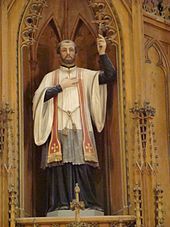 Statue of Saint Francis Xavier, at St. Francis Xavier Catholic Church, in Superior, Wisconsin, United States
Statue of Saint Francis Xavier, at St. Francis Xavier Catholic Church, in Superior, Wisconsin, United States
 Effigy of Saint Francis Xavier in the Monument to the Discoveries in Lisbon, Portugal
Effigy of Saint Francis Xavier in the Monument to the Discoveries in Lisbon, Portugal
As the foremost saint from Navarre and one of the main Jesuit saints, he is much venerated in Spain and the Hispanic countries where Francisco Javier or Javier are common male given names. The alternative spelling Xavier is also popular in the Basque Country, Portugal, Catalonia, Brazil, France, Belgium, and southern Italy. In India, the spelling Xavier is almost always used, and the name is quite common among Christians, especially in Goa and the southern states of Tamil Nadu, Kerala, and Karnataka. The names Francisco Xavier, António Xavier, João Xavier, Caetano Xavier, Domingos Xavier et cetera, were very common till quite recently in Goa. Fransiskus Xaverius is commonly used as a name for Indonesian Catholics, usually abbreviated as FX. In Austria and Bavaria the name is spelled as Xaver (pronounced (ˈk͡saːfɐ)) and often used in addition to Francis as Franz-Xaver (frant͡sˈk͡saːfɐ). Many Catalan men are named for him, often using the two-name combination Francesc Xavier. In English speaking countries, "Xavier" until recently was likely to follow "Francis"; in the 2000s, however, "Xavier" by itself has become more popular than "Francis", and since 2001 is now one of the hundred most common male baby names in the U.S.A. Furthermore, the Sevier family name, possibly most famous in the United States for John Sevier, originated from the name Xavier.
Many churches all over the world, often founded by Jesuits, have been named in honour of Xavier. The many in the United States include the historic St. Francis Xavier Shrine at Warwick, Maryland (founded 1720), and the Basilica of St. Francis Xavier in Dyersville, Iowa. There are also the American educational teaching order Xaverian Brothers, and the Mission San Xavier del Bac in Tucson, Arizona (founded in 1692, and known for its Spanish Colonial architecture).
In art
Rubens painted St Francis Xavier Raising the Dead for a Jesuit church in Antwerp, in which he depicted one of St Francis's many miracles. The Charles Bridge in Prague, Czech Republic, features a statue of Francis Xavier. In front of Oita Station of Oita City, in Oita Prefecture, previously known as Bungo Province in Japan, there is one statue of Francis Xavier. The monument Padrão dos Descobrimentos in Belém (Lisbon), Portugal, features a Francis Xavier image.
Music
- Marc-Antoine Charpentier, In honorem Sancti Xaverij canticum H.355, for soloists, chorus, flutes, strings and continuo (1688 ?)
- Marc-Antoine Charpentier, Canticum de Sto Xavierio H.355 a, for soloists, chorus, flutes, oboes, strings and continuo (1690).
Missionary
Shortly before leaving for the East, Xavier issued a famous instruction to Father Gaspar Barazeuz who was leaving to go to Ormuz (a kingdom on an island in the Persian Gulf, formerly attached to the Empire of Persia, now part of Iran), that he should mix with sinners:
And if you wish to bring forth much fruit, both for yourselves and for your neighbours, and to live consoled, converse with sinners, making them unburden themselves to you. These are the living books by which you are to study, both for your preaching and for your own consolation. I do not say that you should not on occasion read written books... to support what you say against vices with authorities from the Holy Scriptures and examples from the lives of the saints.
— Kadič 1961, pp. 12–18
Modern scholars place the number of people converted to Christianity by Francis Xavier at around 30,000. And while some of Xavier's methods have been since criticised (he forced converts to take Portuguese names and dress in Western clothes, approved the persecution of the Eastern Church, and used the Goa government as a missionary tool), he has also earned praise. He insisted that missionaries adapt to many of the customs, and most certainly the language, of the culture they wish to evangelise. And unlike later missionaries, Xavier supported an educated native clergy. Though for a time it seemed his work in Japan was subsequently destroyed by persecution, Protestant missionaries three centuries later discovered that approximately 100,000 Christians still practised in the Nagasaki area.
Francis Xavier's work initiated permanent change in eastern Indonesia, and he was known as the "Apostle of the Indies" where in 1546–1547 he worked in the Maluku Islands among the people of Ambon, Ternate, and Morotai (or Moro), and laid the foundations for a permanent mission. After he left the Maluku Islands, others carried on his work and by the 1560s, there were 10,000 Roman Catholics in the area, mostly on Ambon. By the 1590s, there were 50,000 to 60,000.
Role in the Goa Inquisition
The role of Francis Xavier in the Goa Inquisition is significant. He had written to King João III of Portugal in 1546, encouraging him to dispatch the Inquisition to Goa. This he did, after seeing mass immigration of Crypto-Jews and Crypto-Muslims from the Iberian peninsula, and the Inquisition had jurisdiction only over Christians and this would help veer them back to the Faith. Francis Xavier died in 1552 without living to see the commencement of the Goa Inquisition, but his Iberian background meant that he was aware of the Portuguese Inquisition's activities. In an interview to an Indian newspaper, historian Teotónio de Souza stated that Francis Xavier and Simão Rodrigues, another founder-member of the Society of Jesus, were together in Lisbon before Francis left for India. Both were asked to assist spiritually the prisoners of the Inquisition and were present at the very first auto-da-fé celebrated in Portugal in September 1540, at which 23 were absolved and two were condemned to be burnt, including a French cleric. Hence, he believes that Xavier was aware of the brutal punishment that could be meted out by the Inquisition against relapsed heretics.
